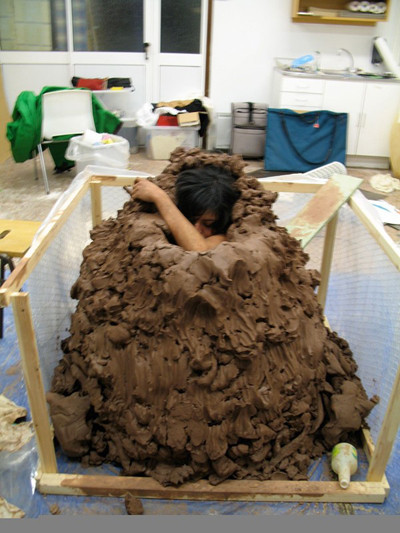In the few years since graduating from London’s Slade School of Art,
Brazilian-American artist Juliana Cerqueira Leite has been building a
reputation as one of the most exciting young sculptors working today –
garnering attention from the likes of Charles Saatchi and New York’s
Sculpture Center. 2012 has proved to be her busiest yet, with solo shows
at Galleria Lorcan O’Neill in Rome and London’s T J Boulting
supplementing her commissions for the 4thMarrakech Biennale and Art
Basel Miami Beach.
Leite’s art focuses on the capabilities and limitations of her own body,
employing repetitive movements and physical exertion to visceral
effect. All of her works are self-portraits but not in the classic
sense, with laborious pushing, crawling, scratching and climbing into
her chosen material without the help of tools her preferred method of
creation. As she does so she is unclothed, affecting the tactile
qualities of the finished cast – impressions of feet, knees, elbows and
fingers defining the surface condition, frozen imprints of her movements
that merge into a strange whole. Dazed caught up with Leite to learn
more about her distinctive process.
Can you briefly explain the general process for making one of your sculptures?
Juliana Cerqueira Leite: I produce a hollow space within a large volume
clay by moving through it. Then I cast a positive version - usually out
of plaster or latex - of the void left behind by my motions. The result
is an amorphous, ambiguous form whose scale relates to my body and the
action that was carried out. The sculptures are shapes that were created
and inhabited by me. Basically, I make negative space positive and
positive space negative.
How does the viewer make sense of this process when experiencing the finished piece?
Juliana Cerqueira Leite: The overall shape of the work is visibly
defined by my movements . Traces of my actions also define the surface
texture of the cast – things like foot prints, knees, elbows, fingers,
marks that are made by moving and removing material while working
without tools.
What about clothes?
Juliana Cerqueira Leite: I don’t really want prints of clothing to
appear. In practical terms, the fabric gets attached to the clay and I
get stuck. Also, I think clothing dates the work. As body casts, the
nude form implies a more transhistorical field. So, no clothes. Only
Chanel No. 5.
Does that mean you’re interested in archetypes?
Juliana Cerqueira Leite: Not in a Jungian way. I more interested primal
activity – a basic interaction between the human body, its ability to
move through space and its interaction with matter. One of the reasons I
use so much density of material is that I want to upset the status quo –
the idea that matter is consistently subservient to our desires. I want
to put myself in a position where matter is in just as much in control
as I am. The work is a negotiation.
How important is time?
Juliana Cerqueira Leite: The sculptures are actions in collapsed time.
My various acts become elongated and blur into one when time is
compressed into a finished three-dimensional form. I’m not interested in
discrete expressive moments. We endow time with this magic power of
erasing and healing because it apparently separates acts. I don’t know
if this is really the case. Time doesn’t erase or heal anything. In the
sculptures, by turning negative space into a mass I’m able to freeze
time and produce a shape that reveals a sequence of actions as one - as
opposed to multiple separate things. In a way, I aim to show the true
shape of action schemes.
How do your sculptures relate to your photography? Your V piece
is, one way or another, a nude descending a staircase. So, we’ve got
Muybridge and Duchamp there…
Juliana Cerqueira Leite: The sculptures preserve a specific sequence of
actions in time, and chronophotography acts in a similar way. The way I
use photography is to overlay actions to find something of their essence
– in the sense that where they overlap most consistently the image is
clearer. With the hollowing out of clay to produce a negative space the
forms that are generated are produced by my repeated intention.
Is this just a formal exercise?
Juliana Cerqueira Leite: No. Its important to push figuration, formally
into new directions. Its important to open up the possibilities for
figuration. Werner Herzog once said that if we don’t create new imagery
that we can use to explain our contemporary experience of being then
we’ll die out like dinosaurs. I think figurative art just stopped in
time. It’s important to generate a body that isn’t fixed and singular –
and promote the sense of embodiment as being full of coexisting
possibilities; mutable and changeable. The antithesis of my interest is a
body fixed and defined by its social functions, by its temporal and
political contexts. A body that isn’t allowed to change is a body as
prison.
